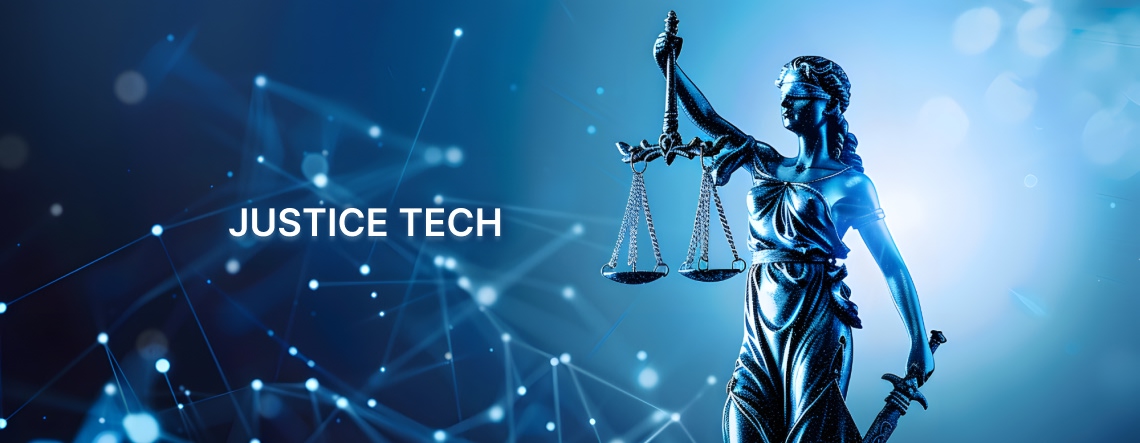Justice Tech is reshaping the legal landscape, making justice more accessible, efficient, and fair. From AI-driven research to online dispute resolution, technology is leading the charge. But how deep is the impact, and what are the nuances of this transformation?
Overview :
- Understanding Justice Tech: A Human-Centric Approach
- Key Areas Where Justice Tech is Making an Impact
- Global Examples of Justice Tech in Action
- Challenges and Limitations of Justice Tech
- The Future of Justice Tech: Trends and Opportunities
- Justice Accelerator: Shaking Up the Norm
- A New Era for the Judiciary
From Code to Courtrooms: How Justice Tech is Changing the Game
-

Amal Purakkal
-
-
Mar 24, 2025
-
16 min Read
-

As unfortunate as it is, it remains a fact that access to justice is a privilege afforded only to a select few. Globally, millions of people face barriers when accessing justice, whether due to cost, complexity, or lack of resources – the reasons are aplenty. According to the World Justice Project, over 5 billion people worldwide lack meaningful access to justice. Thankfully, with technology reshaping industries, the legal sector is not being held back any longer. Justice Tech – a term that encapsulates technology-driven solutions aimed at improving access to justice – has emerged as a powerful force for change. From simplifying legal processes to bridging the gap between underserved populations and legal services, Justice Tech is redefining how we think about and approach the judiciary.
Simply speaking, justice Tech seeks to address modern-day challenges by leveraging innovative tools and platforms that make legal and judicial systems more accessible, efficient, and equitable. But what exactly does Justice Tech do? How is it transforming the judiciary? And how deep is its impact? Let us find out!
Understanding Justice Tech: A Human-Centric Approach
At its core, Justice Tech is the intersection of Legal Tech (technology for lawyers and law firms), Law Tech (technology that delivers legal services directly to the people), and Tech for Good (technology designed to solve social problems). Unlike traditional legal technology, which often focuses on streamlining operations for legal professionals, Justice Tech prioritises the needs of end-users – particularly those who are marginalised or underserved.
Justice Tech is inherently human-centric, aiming to empower individuals by providing them with the tools and resources they need to navigate complex legal systems. Whether it is a single mother fighting an eviction notice or a small business owner resolving a contract dispute, Justice Tech is about levelling the playing field and ensuring that everyone has equal access to justice.
For example, platforms like LegalZoom and Rocket Lawyer have democratised access to legal documents, while tools like DoNotPay use AI to help users contest parking tickets or navigate small claims courts. These innovations are not just about efficiency; they are about equity and inclusion.
Key Areas Where Justice Tech is Making an Impact
Justice Tech is reshaping the judiciary, driving innovation and accessibility across multiple fronts. Here are some of its most profound areas of impact:
Access to Legal Information
- Online Resources: Platforms like ProBono.net are offering free legal guides and self-help tools, empowering individuals to understand their rights and navigate legal processes. For instance, a tenant facing eviction can easily access step-by-step guides on how to respond to a notice or file a counterclaim.
- Multilingual Solutions: Many Justice Tech tools are now available in multiple languages, ensuring accessibility for non-native speakers. For example, ImmigrationHelp.org provides free, multilingual resources for immigrants navigating the U.S. immigration system.
Connecting Individuals to Legal Services
- Matching Platforms: Today, vulnerable populations, such as LGBTQ asylum seekers can easily connect with verified legal service providers through tools like AsylumConnect. Users can search for LGBTQ-friendly lawyers and organisations in their area, and ensure they receive culturally competent assistance.
- Virtual Legal Clinics: Initiatives like ABA Free Legal Answers are allowing users to post legal questions about their civil cases online and receive advice from volunteer attorneys. This is particularly beneficial for low-income individuals who cannot afford traditional legal representation.
Document Automation and Efficiency
- Streamlined Processes: Document automation is all the rage now, and it enables users to generate simple and easily navigable legal forms quickly and accurately, reducing the need for costly legal assistance. Tools like Documate allow users to create customised legal documents by simply answering a series of questions.
- E-Filing Systems: One of the rare by-products of the COVID-19 pandemic, courts everywhere are increasingly choosing to go digital with e-filing systems, and attached court management systems, making it easier for individuals to submit legal documents without visiting a courthouse.
Online Dispute Resolution (ODR)
- Remote Resolution: With tech taking over e-commerce and retail, ODR platforms now allow parties to resolve disputes online, saving time and resources while reducing the burden on traditional court systems. For example, Modria, an ODR platform, has already been used to resolve thousands of disputes related to e-commerce and property claims.
- Global Adoption: Countries like Singapore and the UK have successfully implemented ODR systems, setting a viable precedent for others to follow. In Singapore, the Community Justice Centre uses ODR to resolve small claims and family disputes efficiently.
Global Examples of Justice Tech in Action
Justice Tech is driving meaningful change across the globe, revolutionising access to legal services and judicial processes. Here are some standout examples of its impact in action:
United States
The Florida Justice Technology Center has developed tools to help transgender individuals legally change their names and gender markers, simplifying a traditionally complex process. Their online platform provides step-by-step guidance and automated forms, reducing the need for costly legal assistance.
India
The Supreme Court of India’s e-Committee is working to digitise court processes, including the universalisation of the CNR (Case Number) System for better case tracking. This initiative has significantly reduced delays in case management and improved transparency.
Australia
The Refugee Advice and Casework Service (RACS) uses document automation to streamline asylum applications, enabling faster and more efficient processing. By automating repetitive tasks, RACS has been able to assist more asylum seekers with limited resources.
These transformations highlight the versatility and global relevance of Justice Tech, mere examples that demonstrate its potential to address diverse legal challenges, while bringing communities together.
Challenges and Limitations of Justice Tech
While Justice Tech holds immense promise, it is not without its unique set of challenges:
- Digital Divide: Limited access to technology and the internet can exclude some populations from benefiting from Justice Tech solutions. For example, rural communities or low-income households may lack the necessary infrastructure to use online legal tools.
- Ethical Concerns: With AI gradually taking over, questions about bias, transparency, and accountability are still cause for concern with deliberating AI-enabled automation. In several countries, regulations have been placed that monitor AI algorithms used in predictive policing or sentencing to avoid perpetuating existing biases.
- Regulatory Hurdles: Legal systems are often slow to adapt, requiring regulatory changes to fully embrace Justice Tech innovations. For example, the adoption of e-signatures and remote notarisation required legislative changes in many jurisdictions – it is still held-up in many others.
Addressing these challenges will require collaboration between governments, lawmakers, the judiciary, NGOs, and the private sector to ensure that Justice Tech is inclusive and equitable.
The Future of Justice Tech: Trends and Opportunities
The future of Justice Tech is bright, with several emerging trends poised to drive further innovation:
- Artificial Intelligence (AI): AI-powered tools can analyse legal documents, predict case outcomes, and provide personalised legal advice. For example, tools like ROSS Intelligence use AI to help lawyers conduct legal research more efficiently.
- Blockchain Technology: Blockchain can enhance the security and transparency of legal processes involved in evidence storage, document management and contract management. For instance, Smart Contracts on blockchain platforms like Ethereum can automate contract execution without the need for intermediaries.
- Collaborative Ecosystems: Partnerships between tech companies, justice departments, legal professionals, and policymakers will be crucial for scaling Justice Tech solutions. Organisations like the Justice Technology Association (JTA) do just that. They bring together startups, nonprofits, and investors to promote ethical Justice Tech innovations.
As these trends evolve, Justice Tech has the potential to democratise access to justice on an unprecedented scale.
Justice Accelerator: Shaking Up the Norm
Among the many players in the Justice Tech space, Justice Accelerator stands out for its unique approach and impact. Unlike traditional initiatives, Justice Accelerator focuses on fostering human-centric solutions that address the root causes of legal inequities. By collaborating with practitioners with lived experience in the justice system, who have vested interest in its success and ability to be fair and equitable, Justice Accelerator ensures that its solutions are both practical and impactful.
Driving Innovation in the Justice Sector
Justice Accelerator is at the forefront of transforming legal systems through cutting-edge technology. By leveraging AI, automation, and digital solutions, it empowers users to reshape access to justice for individuals and institutions alike.
Bridging the Gap Between Law and Technology
With a strong focus on practical, scalable solutions, Justice Accelerator ensures that technology serves the legal sector effectively. From streamlining legal processes to enhancing judicial efficiency, its solutions are designed to create lasting impact.
Building a Global Community of Changemakers
Justice Accelerator connects forward-thinking legal professionals and members of the judiciary to foster collaboration and drive meaningful change. Through its network, it accelerates the development and adoption of Justice Tech solutions worldwide.
A New Era for the Judiciary
Justice Tech is ushering in a new era for the judiciary – one where access to justice is no longer a privilege but a right. By leveraging technology to simplify legal processes, connecting individuals with resources, and addressing systemic inequities, Justice Tech is transforming the way we think about the law. As we look to the future, it is clear that the potential of Justice Tech is limitless. But realising this potential will require continued innovation, collaboration, and a commitment to equity. The goal is simple: build a legal system that works for everyone. And the path to get there? Following the ‘digital code’ – our very own Yellow Brick Road to justice – seems like the smartest way forward.
-
Topics:
-

-
Amal Purakkal
Amal is a young and upcoming content writer who is passionate about exploring the latest innovations and trends in technology. With a focus on breaking down complex ideas, and at the same time, building narratives that shape crucial discourses, Amal highlights the transformative impact of emerging technologies on society, industries, and all our lives in general.



 +971 50 9295048
+971 50 9295048  +91 9746059514
+91 9746059514